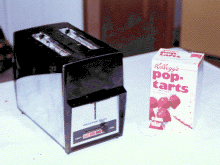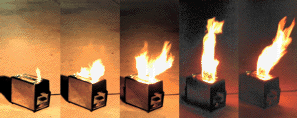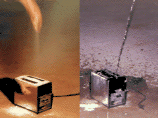 Strawberry Pop-Tart Blow-Torches
Strawberry Pop-Tart Blow-Torches
 Strawberry Pop-Tart Blow-Torches
Strawberry Pop-Tart Blow-Torches

Figure 1. Toaster and Strawberry Pop Tarts
In addition to the basic materials, a number of safety-related items were needed to conduct this experiment. First, a suitable location for the experiment was required, it being expected that the kitchen was not the appropriate place for blow-torching SPTs. The author's driveway was chosen as a suitable site. Second, an appropriate means for extinguishing the SPTs would be needed; a research assistant brought along some baking soda for the purpose.

Figure 2. Preparation of Toaster and SPT
Next, the toaster and SPT were taken to the driveway, and an extension cord was arranged to provide power to the toaster. At this point, we were ready to begin the experiment.

Figure 3. Toaster Prepared for SPT combustion
(At this point the researchers became somewhat concerned that the noise from the toaster would wake the neighbors and attract undue attention. However, we decided that we were already committed to the experiment and that the neighbors would be able to sacrifice some sleep in the name of science.)
Soon thereafter, large amounts of smoke began pouring out of the toaster. The researchers noticed that some of the neighbors down the street were beginning to get a little curious, but the experiment proceeded nonetheless. Approximately 40 seconds later, small flames began licking their way out of the toaster. The flames steadily grew larger and larger until reaching a maximum height of about 18 inches above the top of the toaster. Figure 4 presents a time-series collage of the flames emitted from the SPT.

Figure 4. Time Series Photograph of Flaming SPT
As the flames were reaching their maximum height, the toaster abruptly stopped making buzzing noises. We speculate that the flames had by this point shorted the electronics within the toaster. The toaster was quickly disconnected from the primary electrical source to avoid any potential damage to the author's house. At this point, the researchers also realized that the heat could inadvertently melt the adhesive cellophane and cause the flaming SPTs to suddenly eject from the toaster. Unfortunately, this did not occur. The flames continued for several minutes.
At this point there was some slight concern that the flames might take considerable time to diminish. We then enlisted the help of a reluctant research assistant to sprinkle baking soda on the flames. (The reluctance was understandable given the potential for premature SPT ejection described in the above paragraph.) The baking soda quickly extinguished the flames and produced still further smoke (Figure 5a).

Figure 5. Extinguising the SPT
Once the flames were extinguished, the researchers noted an unanticipated problem: what to do with the (now defunct) toaster and the spent SPT. It became obvious that the toaster could not be returned to the author's house due to both a continued potential fire hazard and the smell of burnt strawberries. In addition, it was noted that the toaster was still "too hot to handle," necessitating the use of a nearby garden hose to cool the toaster off. This is illustrated in Figure 5b. Finally it was decided to just leave the toaster by the curb for the sanitation experts to pick up the next morning (Figure 6.)
We did desire to repeat the experiment with the remaining five SPTs, but we could not do so because there were no more suitable toasters available for further experiments. In the future, we recommend that toasters be sold in six-packs to accomodate important SPT research. Instead, the remaining SPTs were sacrified over the course of the next several days in private, undocumented consumption experiments.
The response to my Strawberry Pop Tart article has been overwhelming. In October 1994 alone it's been accessed more than 2000 times. Here are some of the terrific followup messages I've received:
 Patrick R. Michaud/pmichaud@pobox.com
Patrick R. Michaud/pmichaud@pobox.com